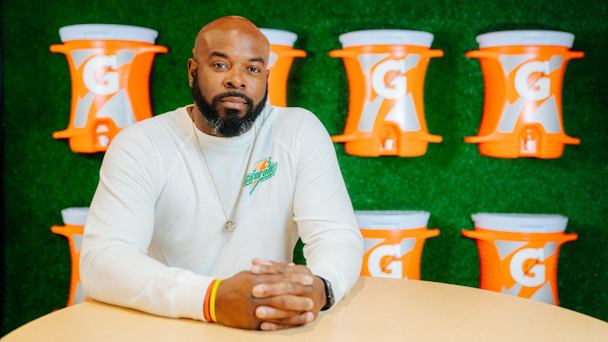Gatorade CMO Kalen Thornton on fueling sports culture and the brand’s resurgence
While BodyArmor blinks, Gatorade looks to accelerate its growth with a three-pillar plan designed to keep the brand relevant for years to come.

Thornton: ‘We are at the precipice of the evolution of Gatorade’
Massive supply chain issues, pesky competitors and an aging brand image were just a few of the challenges plaguing Gatorade last year. Now as we head into the back half of the summer of 2022, the brand is revitalized – gaining both dollar share and renewed cultural credibility.
As part of this resurgence, Gatorade is launching its new ‘All For Fun’ TV spot today. Playful and upbeat, it focuses on the sports stars of the future and the joy of collaborating with teammates. Jacksonville Jaguars quarterback Trevor Lawrence and college basketball star Paige Bueckers make their first appearances in a Gatorade ad. They join Fernando Tatis Jr (San Diego Padres), Olympian Sydney McLaughlin and Karl Anthony Towns (Minnesota Timberwolves.)
The spot attempts to combat the fact that a majority of kids quit sports by the time they are 13 because it’s just not fun any more. This insight was gleaned from a recent study from the National Alliance for Youth Sports.
The ad, created by TBWA\Chiat\Day LA, is Gatorade’s latest celebration of the fun of sport – which is core to the brand’s overarching ‘Fuel Tomorrow’ campaign. This focus on positivity and younger athletes is just one page from the new playbook drawn up by chief marketer Kalen Thornton. A little more than a year ago, the PepsiCo-owned brand brought in the former Nike marketing exec, and Dallas Cowboy linebacker, to modernize the 57-year-old brand. Thornton laid out three pillars: leaning into youth culture, inclusivity and innovation.
“We are trying to go from the notion of being a sports fuel company to a brand that’s fueling sport culture and athletic wellness,” says Thornton. “We really are at a precipice of the evolution of the brand.”
The timing of the soon-to-be pervasive ‘All For Fun’ spot, as well as the energy put behind new products such as Gatorlyte (for rapid rehydration), Gatorade Fit (no added sweeteners, artificial flavors or colors) and the runaway hit Gatorade Zero (zero sugar), is fortuitous. Upstart sports drink BodyArmor had shaken up the category with both its innovation and attitude, leading to purchase of the brand by Coca-Cola for $5.6bn. Now as Coke integrates the brand into its system, BodyArmor sales have slowed. This has given Gatorade a chance to reassert its dominance.
“Gatorade is working very hard to get to a 70-plus share of the sports drink segment by volume. It is boosting production capacity. It has a growth engine in Gatorade Zero. And it is doing the type of marketing that is focused on brand to try and get back to the heights it had before,” says Beverage Digest editor Duane Stanford. “You’ll see it taking as much advantage as it can while BodyArmor transitions into Coke ownership.”
Peeking inside the new Gatorade marketing playbook
The plans for getting Gatorade back on track have been more than a year in the making. Last year, Thornton mapped out his initial strategy to The Drum. He made it clear that Gatorade aspired to serve “a broader aperture of athletes.”
This includes boosting its media investment in women’s sports by 10 times during the next five years. Gatorade also committed more than $10m to help aspiring athletes get access to community programs, facilities, equipment and transportation. Additionally, it has been promoting its ‘How to activate allyship’ guide.
“‘Fuel tomorrow’ has been a year-long journey,” says Thornton. “It’s awesome in terms of how our athletes and consumers, broadly speaking, are acknowledging and noticing it as a progression of the brand ... The business is headed in the right direction after some headwinds last year. We feel really good about the momentum.”
The brand’s ‘All G’ portfolio of products (Gatorade Zero, Gatorade Zero with Protein, Gatorlyte and Gatorade Fit) has been a major contributor to this momentum shift. Gatorade had been criticized for failing to innovate – instead leaving it up to smaller, more aggressive competitors such as BodyArmor, BioSteel and Jerry Rice’s GOAT Fuel. But that has changed.
Gatorade Zero, in particular, has been a star performer. “A lot of growth is on the back of Gatorade Zero, which has grown quite well and helped the entire trademark overall as consumers look for options with less sugar,” says Stanford. Trademark Gatorade dollar sales were up 12% for the first half of the year, per Beverage Digest.
Innovation has also touched its bottle design. Earlier in the summer, Gatorade launched its first Gx bottle collection, which was created by some of its youngest roster athletes alongside the brand’s design team. “The collection showcases how the brand will utilize its equipment as a blank canvas for athlete expression to spotlight athletes’ off-the-field personas,” per the company.
Thornton says innovation will stretch far beyond just beverages. Gatorade’s Gx system, which includes a sweat patch that helps you monitor your body via an accompanying app, has been a hit. “There are some exciting things coming around the corner there ... you’ll see more innovation from a multitude of fronts. I won’t try to be too cryptic, but it’s not always going to be the liquid in the bottle. There are solutions that we are going to bring to market, in the short-term, that are meant to serve that 360° lens around athletic wellness.”
Will this include the old-school cult favorite Gatorgum? “I get asked that question daily,” says Thornton. “I don’t have an answer for it yet, but I know there’s a lot of demand out there.”

